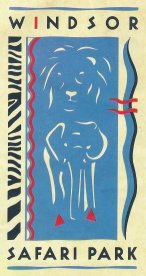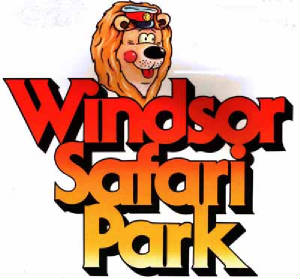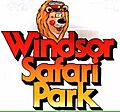Windsor Safari Park facts for kids

Safari Park logo
|
|
| Date opened | 1969 |
|---|---|
| Date closed | 1992 |
| Location | Windsor, Berkshire, England, United Kingdom |
| Coordinates | 51°27′49″N 0°39′04″W / 51.46351°N 0.65114°W |
Imagine a huge park where you could drive your car right through areas filled with wild animals! That was Windsor Safari Park, a super popular family attraction located near Windsor in England. It was known as "The African Adventure" and offered a unique way to see animals up close.
The park had special drive-through areas where you could see big cats like lions, tigers, and cheetahs. There were also bears and baboons roaming around. Beyond the drive-through, you could find a "Serengeti" zone with camels, llamas, giraffes, zebras, and buffalo. The park also had elephants, hippos, chimpanzees, and many different kinds of birds and butterflies.
A big part of the fun was the dolphinarium, called Seaworld. Here, you could watch amazing shows with dolphins, a killer whale, penguins, and sea lions performing cool tricks.
Windsor Safari Park first opened its doors in 1969 and was a favorite spot for families for many years. Sadly, the park closed down in 1992. Today, the land where the safari park once stood is home to Legoland Windsor, another fantastic theme park!
Contents
Park History
The story of Windsor Safari Park began when Billy Smart Sr., a famous circus owner, bought a large estate called St. Leonard's in the mid-1960s. After he passed away, his sons – Billy Smart Jr., David Smart, and Ronald Smart – decided to create something special. They opened the Royal Windsor Safari Park in 1969.
The park was built on 144 acres of beautiful land in Windsor. It quickly became famous for its drive-through animal enclosures. Visitors loved seeing lions, tigers, cheetahs, and baboons living in habitats that felt natural. The park also added a "Serengeti" area with animals like giraffes and zebras, an elephant home, and a hippo lake.
Dolphin Shows and Research
One of the most exciting attractions was Seaworld, the park's dolphinarium. This was a special place where marine animals like dolphins, a killer whale, penguins, and sea lions lived. They put on amazing acrobatic shows for the public, which were a huge hit!
The park wasn't just about entertainment; it also cared deeply about dolphins. They worked with wildlife experts and scientists to learn more about these intelligent creatures. They even tried to develop a warning system for fishing nets to help protect dolphins in the wild. They also had a Dolphin Research Project to raise money for more studies on how dolphins communicate.
Changes and Closure
Windsor Safari Park was very popular, attracting up to 2.5 million visitors every year. It grew a lot during the 1970s and 1980s. In 1988, the park was sold to a company called Themes International. The new owners had big plans to make it even better, adding African-themed restaurants and new rides like the African Queen Riverboat.
However, despite investing a lot of money, Themes International faced financial difficulties. The number of visitors started to drop, and the cost of building new themed areas, like an Egyptian-style entrance, became too much.
Because of these problems, Windsor Safari Park had to close its doors in 1992. Soon after, the Lego Group bought the land. Their dream was to build a Legoland theme park, just like the one in Denmark. This dream came true when Legoland Windsor opened in 1996.
What happened to the animals? The dolphins from Seaworld were moved to a new home at Dolfinarium Harderwijk in the Netherlands. Today, only one attraction from the old safari park remains: a funicular railway that takes visitors up and down a hill. It's now called the Hill Train at Legoland Windsor.
In Films and TV
Windsor Safari Park was such a unique place that it appeared in several films and television shows:
- In 1976, an episode of the BBC show The Fall and Rise of Reginald Perrin featured a family trip to the park.
- The 1976 movie The Omen filmed some of its zoo scenes, including the famous "crazy baboons" part, at the park.
- The film Mutiny on the Buses (1972) showed characters driving a London bus through the lion enclosure!
- The action scenes for the 1983 film The Jigsaw Man, starring Michael Caine, were also filmed there.
- The British romantic comedy Follow Me! (1972) had a few short scenes filmed at the park.
- In 1989, Annabel Croft visited the park for the quiz show Treasure Hunt to find a clue in the lion enclosure.
- A 1988 video called Go Wild at Windsor showed many of the park's animals, the dolphin show, and rides.
- The 1988 Doctor Who story Silver Nemesis was partly set in the park, though some scenes were filmed elsewhere.
- An episode of the children's TV show Art Attack in 1991 featured Neil Buchanan visiting the park.
Images for kids




